HISTORY OF CLARKE COUNTY ALABAMA by John Simpson Graham
HISTORY OF CLARKE COUNTY
By John Simpson Graham
Extracted from:
HISTORY OF CLARKE COUNTY
BY JOHN SIMPSON GRAHAM
Press of
BIRMINGHAM PRINTING COMPANY
Birmingham, Ala.
1923
Clarke County is situated between the Alabama and Tombigbee rivers, extending from the cut-off on the south, north to the north boundary line of the south third of Township 12, a distance of about 65 miles. The county has an area of about 1,200 square miles, or 768,000 square acres, and has a population of between 31,000 and 32,000. The county is not bounded on the east its entire length by the Alabama river, there being a small strip of territory on the west side of the Alabama river belonging to Monroe County. The county varies in width, owing to the meanderings of the two rivers, its greatest width being about 35 miles.
Clarke County was established in December, 1812, by an act of the legislature of the Mississippi territory. However, the county did not embrace as much territory then as it now does. It was carved out of Washington County, taking in all the territory of that county lying east of the Tombigbee river and west of the Choctaw County boundary line, and from the south boundary line of Township 5 to a line running from Choctaw corner to the Tombigbee river. Alabama was made a territory in November, 1817, when some more territory was added to Clarke County. Mississippi was admitted to the Union in the same year (1817). Alabama was admitted into the Union in December, 1819, and later on the boundary lines of Clarke County were established as they now stand.
What was here 1000 or even 500 years ago we are left to draw upon our imagination. We are reasonably sure, however, that there were here the same hills and valleys we now have; the same forests (though more dense than now); the same lakes and flowing streams; the same babbling brooks and bubbling springs; the same kind of wild games. Doubtless there were in large numbers, the bears, the wolf, panther, the wildcat, the catamount, the fox, the raccoon, the opossum, the otter, the mink, the squirrel, the deer, the turkey and other small game, for we now have all these things (in smaller numbers), except the panther and the wolf.
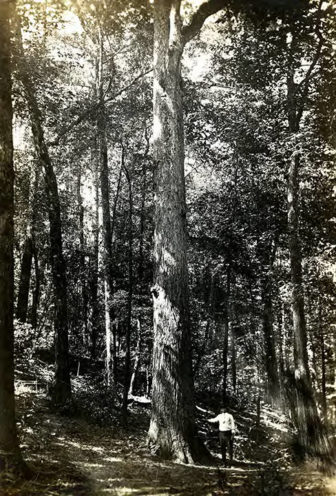
Clarke County is a rich agricultural section. In this county there are large sections of chocolate soil susceptible of the highest state of culture, with a great variety of growth. There are also large tracts of gray soil underlaid with clay subsoil, making it well adapted to almost any variety of farm or fruit growth. The county also contains large tracts of rich alluvial river and creek botton [sic] lands especially adapted to corn and forage crops. Thousands of acres of black lime hill lands are found in the county, furnishing soil conditions as well adapted to grape and fruit culture as are the great fruit sections of California.
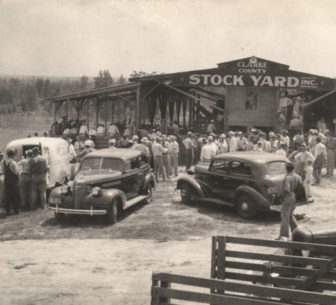
The county is well adapted to the raising of all kinds of live stock, the climate being so mild that it is not absolutely essential to house at any season of the year. The velvet bean, which agricultural statistics show to be the cheapest and most valuable feed, will grow profusely on all soils with little cultivation and no fertilization. This bean is a southern plant and matures only in the extreme south. There are also a large number of native grasses on which cattle, thrive.
Sheep raising could be made profitable in the county, there being several hundred thousand acres of cut-over land which would furnish fine grazing for sheep. However, in order to get the greatest profit out of the business, it would be advisable to have a large flock, large enough to justify the employ of a shepherd to look after them as David looked after his father’s sheep in the olden times. Dogs are very destructive to sheep, and they would have to be protected from the ravage-prowling cur. We have no stock law in this county, and if the dogs could be gotten rid of there would be no drawback to sheep raising.
Crops can be grown here abundantly in every season of the year. Spring crops are cotton, corn, sugarcane, Irish potatoes, velvet beans, etc. Summer crops are sweet potatoes, peas, .peanuts, Soudan grass, sorghum, etc. Fall crops are clover, hairy vetch alfalfa and all cover crops.
Trucking can be carried on the year round, there never being a time of the year that some of the different crops of this nature cannot be raised for the market. Soil and climate are adapted to any of the truck crops that can be raised in the temperate zone. Our principal truck crops are strawberries, cantelopes, watermelons, Bermuda onions, snap beans, cucumbers, cabbage, collards, sweet potatoes, Irish potatoes, English peas and sweet corn.
Peaches, pears, apples, Satsuma oranges, grapefruit, Japanese persimmons, plums, apricots, pomegranates, etc., are grown extensively and produce enormous crops.
The South is the home of the pecan tree. Paper-shell pecan nuts cannot be grown more successfully anywhere else in the world. These are the highest priced nuts in the world and the richest food value. No other nut touches it either in price or in quality. The demand is increasing every year and prices are advancing. An acre of bearing trees is worth $1,000. In fact, there are many groves that a thousand dollars an acre will not buy. This industry is now entirely at its formative stage and on a sound business basis, and thousands of dollars are being invested in it annually by some of the shrewdest business men and financiers of the country. This immediate section is peculiarly adapted to the growth of the nut.
The county offers many enterprises. Rabbit Creek has several water-power sites which would develop three to four hundred horsepower per site. Bassett Creek has an ideal factory site which would furnish at least four hundred horsepower. Rabbit Creek empties into Bassett Creek and Bassett Creek empties into the Tombigbee River a few miles below Jackson.
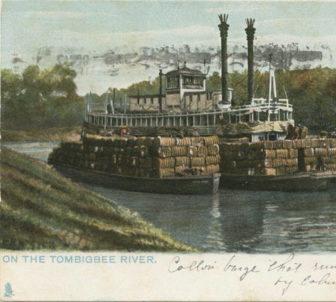
The Tombigbee River is one of the largest in the South and is navigable from Mobile to the coal fields of Alabama. The government has spent something like four million dollars on locks and other improvements for this stream, making it today the most important river in the United States, for through its seventeen locks now pass many large steamers and self-propelled barges plying between the coal fields and Mobile, the most logical port on the Gulf of Mexico and the natural gateway to the Panama Canal.
The lands along this stream are as fertile as any in America and produce crops in abundance. Thousands upon thousands of acres of these rich bottom lands yet lie virgin, uncleared and uncultivated, and can be bought for a small sum per acre. Once cleared and put into cultivation, the land becomes very valuable from two prominent and important facts: First, it produces from a half to one bale of cotton and forty to forty-five bushels of corn per acre, and other crops in equally as large proportions, without the use of commercial fertilizer, there never being any need for this costly item which has ruined many farmers. The value of these lands is not realized by their present owners, and today it can be bought for a meagre sum, but once the real worth becomes demonstrated there will be a fabulous price asked. Today is the time for the land seeker to buv. Along the banks of this river and on lands that can be bought for a low price are some of the finest hardwood timbers that can be found in the whole country and the supply is almost inexhaustible.
The steamboats that ply the Tombigbee are not surpassed by the finest packets on the Mississippi.
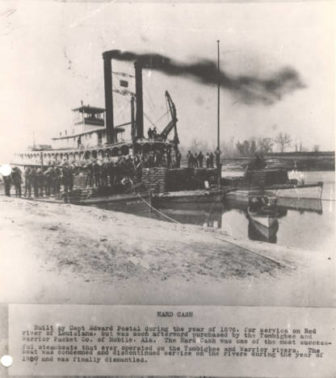
From a pleasure standpoint, one could want nothing better than a week’s trip up the river on one of these palatial boats. viewing the magnificent scenery which is unsurpassed by even the famous Hudson.
The waters of the river are abounding in fish of all varieties, ranging from the shark to the smallest of the finny tribe.
For the sportsman this county is a paradise either for fishing or hunting. All the wild game known to the South abounds, such as bears, deer, turkeys, geese, ducks, quail, doves, squirrels, etc. Besides the river, there are a number of lakes and streams that furnish fishing. In these are found bass, trout, all kind of perch, and the larger fish for market purposes. There are a number of families around in the county who secure their livelihood from this source.
Besides the numerous things mentioned above, there is found in the county inexhaustible quantities of yellow ochre and china clays. A large ochre plant is established two and a half miles north of the depot of Jackson, which will receive particular mention later. There is also a quantity of Fuller’s earth found in the county, many other valuable things which will receive attention later on.
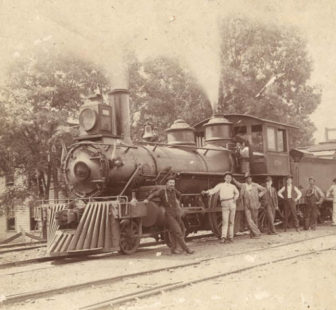
The Southern Railroad passes through the county, crossing the Tombigbee River and entering Clarke County quite near the north boundary line of fractural Section 18, Township 6 North, Range 2 East, and running in a northeastward direction alone: the valley of Bassett Creek and passing out of the county a short distance north of Thomasville. On the completion of this road, the county took on new energy and has progressed rapidly since that time. This road was completed through the county in 1887. Nothing builds up a country like railroads. Having the Alabama River on the east and the Tombigbee on the west and a railroad passing through the county, the shipping facilities are as good as one would wish. There are hundreds of saw mills scattered throughout the county and lumber is being shipped from this county to all parts of the world. We will make particular mention of some of the more important saw mills of the county on other pages of this book.
Extracted from: HISTORY OF CLARKE COUNTY BY JOHN SIMPSON GRAHAM Press of BIRMINGHAM PRINTING COMPANY Birmingham, Ala. 1923

I am a little further south in Mobile County and we had pomegranates in our yard when I was young. I planted one last year, it was a puny little thing, and it has doubled in size this spring. Looking forward to having them again.
I had no idea that pomegranates would grow here!